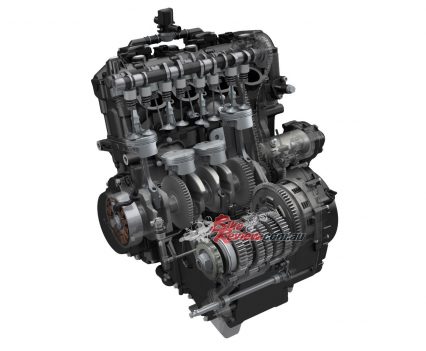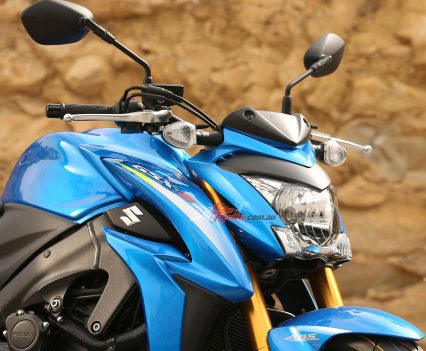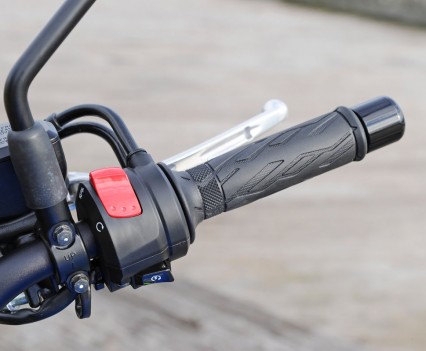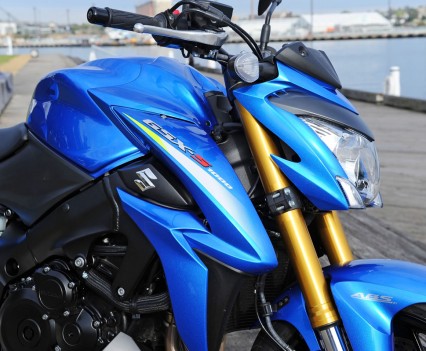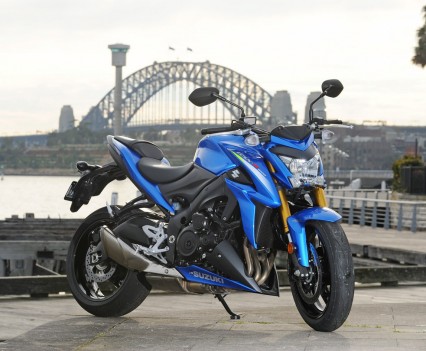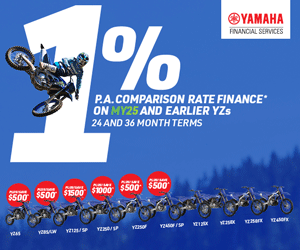K5 Power! Exactly a decade ago Suzuki Australia flew us to Madrid to test the then all-new GSX-S1000 nakedbike. The grunty, agile nakedbike was a hit, and a decade later continues to impress...
Exactly 10-years ago, Suzuki launched the GSX-S1000 nakedbike. Boasting power from the much loved and arguably best ever 1000cc GSX-R engine, the K5 powerplant, the GSX-S was an instant hit. A decade on, 2015 models are still a fantastic, grunty, fun nakedbike.

The Suzuki GSX-S1000 Development Team was led by then Suzuki MotoGP boss Shinichi Sahara (second from right).
When I headed to Alicante in March 2015 to be among the first lucky journo’s to ride the much anticipated GSX-S1000, I was expecting big things. First of all, seats up the front don’t come cheap. Suzuki must have big expectations for sales success… I had 24-hours travel to ponder these things and more about the GSX-S1000. One thing I did know was it wasn’t going to be the arm wrenching raw Gixer K5 with MX ‘bars many had hoped for, but more a refined ride… I was right, but so was Suzuki.
There are currently some great deals on the current GSX-S1000 from $17,590, click the ad above… Read our later model GSX-S1000 reviews here…
THE 2015 LAUNCH
The very first thing I consider when it comes to wanting, needing, owning, craving or even considering purchasing a motorcycle is – would I sit in my garage on a rainy Sunday night, drinking beer, just looking at and admiring the curves? Would I glance at the bike every single time I walk through my garage and smile? For me, very few nakedbikes pass this test but plenty of sportsbikes do. I like fairings. I have nine bikes and eight of them are sportsbikes… However, I’ve busted my back twice. I’m 40. I’m a bit overweight and I think it’s time for a nakedbike – without losing the fun.
It’s not purely a looks thing – it’s a connection and an emotional visual experience I’m after in a bike. I have a connection with some and not with others. The GSX-S1000 connected with me as soon as I saw it. Somehow the curves of the tank and the radiator shrouds, from a certain front three-quarter angle, reminded me of my old GSX-Rs and Hayabusas. I was thinking about the bike after I saw it and then later sat on it and I could not help but think about it a lot more. What that did for me was confirm that Suzuki did some outstanding research during the development and concept period of the GSX-S.

Suzuki diving into the nakedbike market came after plenty of market research into what their target demographic was.
I’m almost the perfect target market for them according to their press kit – 50-years-old now in 2025, sportsbike rider, experienced, don’t like gimmicks or too many gizmos to play with, seek quality and style in a motorcycle and appreciate easy to ride, great handling and smooth power delivery these days on the street instead of outright performance.
“For me to look at a bike and want one without a ride is a rare thing… But it happened…”
2015 was a big year for Suzuki – the 30th Anniversary of the GSX-R750, the 10th Anniversary of the GSX-R1000 K5 (that powers the GSX-S1000) and the 35th Anniversary of the GSX range. So what a great way to celebrate with a new machine. I had a K5 GSX-R1000 and now 10-years later, I’m 40 not 30 and I’m able to buy a bike with a chassis that suits my old bones but still has that K5 engine I loved. I can’t help but think that a lot of GSX-S1000 owners will be people who once had a GSX-R1000 K5…
While the GS750 was Suzuki’s first four-stroke inline four, it was the GSX range that kicked off Suzuki’s four-stroke 16-valve lineage. The original concept of the GSX series from the 750E to the 1100S Katana was high performance yet with a broad powerband, nimble handling and great durability. Suzuki has continued this tradition with the new GSX-S1000. In case you are wondering, the GSX family starts with the new GSXRR MotoGP bike (Prototype), then the GSX-R comes next (Racing) followed by the GSX-S (Street Sport) and GSX-F (Sport Standard).
According to the Suzuki press kit, handed to us at the World Press Test in Alicante, Spain, the GSX-S concept is that it had to be a bike with the spirit of the GSX-R, ready for the street. After spending a full day testing in the Spanish sunshine, I can tell you, Suzuki have pretty much nailed that brief…

The first few rides showed off just how spectacular of a bike the GSX-S 1000 was at the time of the launch.
THE RIDE
At the end of 2014 I spent two days riding all the middleweight and big bore nakedbikes on the market – both on the street and on a private testing facility. For my flight to Spain, I dug my 35-pages of notes out from that test and read through them. Not to compare the GSX-S to the others, as they really are split into quite a few sub-categories but more to remind myself of what I like and don’t like about a big capacity sports nakedbike. I really did not know what to expect of the GSX-S – but I was hoping that it was not too boring, yet not too crazy. For me, it had to be just a nice, fast, easy ride…
“I really did not know what to expect of the GSX-S – but I was hoping that it was not too boring, yet not too crazy”…
First impressions last and as soon as I sat on the bike I knew I would like it. The riding position made me feel familiar and at home. You sit ‘in’ the bike not ‘on’ the bike and the Renthal Pro Taper ‘bars are at a fantastic level in relation to the seat. The fuel tank is nice and tall and the footpegs roomy. It’s a very neutral and relaxed riding position.
Firing up the bike requires a single push of the button rather than holding it down and no clutch-in is required, so as I gear up I hit the button. The GSX-S idles with that GSX-R raspy growl we all love. It sounds smooth but angry. I blip the throttle as I hop on and a short, sharp note fires out of the stubby exhaust tip. Nice. Exciting. Fun… It takes just a few kilometres to be completely comfortable on the GSX-S. Initially short-shifting through the smooth, positive gearbox as we make our way out of Alicante to the hills for our photoshoot, I soon begin to explore the mid-range of the bike and I’m impressed.
It pulls from 2500rpm like a freight train and accelerates hard through 5000rpm – 6000rpm for a very meaty mid-range area. The intake noise is howling and addictive and the exhaust is one of the best, if not the best, sounding standard pipes I can remember hearing. I would only change it for style not for sound… The road opens up briefly and I glance at the dash – we’re averaging 160km/h in top gear en route to the shoot. So, with some room ahead I drop back to fourth and take it to the rev limiter. The top end acceleration makes me laugh inside my helmet – along with the fact that I’d be arrested in Australia for this hooning!
It’s not GSX-R1000K5 top-end but it is GSX-R1000 K1 top end – more than enough for a bike with no fairings! Acceleration is really impressive – this bike is a V8 with handlebars… it does not drop off up top, it just keeps on pulling harder until the limiter cuts the fun. The only issue I am dealing with is an abrupt initial throttle snatch from a closed throttle. It happens at any rpm and can only be dampened using some rear brake preloading prior to opening the throttle. I’m hoping this is a pre production issue with the ECU/tune of the bike. Once that initial ‘snap’ is dealt with, the throttle is fantastic – a real one-to-one feeling with the back tyre.

The bike didn’t drop off the power when it got to the top of the rev range. It just wanted to keep on going.
The gearbox ratios and overall gearing suit the K5 powerplant well and I would not change the final gearing at all. There is also plenty of engine braking but no rear wheel hop on downshifts, thanks to the back-torque limiting clutch. Like any nakedbike of course, there is no wind protection, so sustained speeds of over 140 – 150km/h are literally a pain in the neck… However, below those speeds the ride position is comfortable.
“A big tick there for Suzuki. The GSX-S1000 is great handling bike”..
The first corners I arrive at turn out to be the photo location – so despite being unfamiliar with the bike and it being quite early in the morning, I have to style it up for the shoot on a range of awkward, narrow, low speed double-apex corners! The GSX-S chassis is so nicely balanced with a natural, confidence-inspiring feel and a feeling of good mechanical grip that I am able to get straight into the knee down action shots, despite cool tyres. Cornering the GSX-S is effortless. In fact, it out-handles the GSX-R in these conditions. Where I look, the bike follows. It tracks my vision and a bike that does that is a bike with very good geometry that makes riding a fun experience – not a tiring or draining experience. A big tick there for Suzuki. The GSX-S1000 is a great handling bike…

“The GSX-S chassis is so nicely balanced with a natural, confidence-inspiring feel and a feeling of good mechanical grip that I am able to get straight into the knee down.”
Ground clearance is fantastic and even at knee down angles the footpegs only touch if there are bumps mid corner. Riding position is not important either, again proving the good chassis geometry. I tried sitting upright, hanging off, half hanging off, sitting forward and back while riding and cornering and none really made a difference – the GSX-S just got on with the job of tracking nicely through the turns. The bike is really stable and I notice as I accelerate hard out of turns, some with crests, that there is no sign of wiggle or headshake. Changing direction is not a problem, either, as I discover a few times. The first situation is a large boulder that has fallen on the road – and I am flat-out in second gear when I see it, quickly changing line while already committed to the turn – with no problem.
The next steering test is a cyclist in the middle of the lane on an uphill blind corner and the third is a lady in a car on my side of the road! In each ‘test’ the GSX-S helped me save myself from a big crash… this is a great steering motorcycle. The Dunlops offer good grip but as I negotiate yet another tight, twisting Spanish mountain I would like more feel from the tyres – particularly the front. I’m braking incredibly hard right up to the apex of some turns – some downhill and although I have no moments I would like more front tyre feel just for confidence. The rear grips well aside from a big slide on a typically slippery Spanish white road marker line that no tyre would find grip on. It’s the only time I feel the traction control working. It saves my skin actually… at least from a big highside.

The Spanish mountain roads had their fair share of obstacles that the GSX-S was able to negotiate with ease.
The brakes are a good package. The test loop I’m on is perhaps one of the hardest tests of front brakes I’ve ever come across on the road. It’s a good 150km this section, of non-stop hard braking, hairpin after hairpin, a lot of it downhill – and the brakes do not fade at all, despite me squeezing them so hard I’m using the ABS almost every corner entry. The brakes do lack some initial bite and they need a good, hard squeeze at the lever but this is a good setup for a nakedbike with road-based fork settings. Any sharper on the brakes would mean a change in those springs and settings.
The rear brake is great for cornering and I’m using it like a throttle for the tight parts as I carry some trailing throttle – due to the throttle snatch I mentioned earlier. I’m not tiring at all on the GSX-S, despite the heavy braking and acceleration. The ride position allows me to really utilise my legs and the tank gives me support on the brakes, not to mention the big, wide Renthals. The standard footpeg position suits me and I would not fit adjustable rearsets and the seat is comfy – no aches after five or six hours in the saddle… After a quick lunch stop somewhere on the side of a mountain, I head off with the group, this time hoping for some bumps. So far the roads had been billiard table smooth and I know this is not what we have back home!
I get what I hope for and I’m soon screaming along flat-out on a bumpy, snotty goat track of a road. The GSX-S remains stable and composed but the suspension does not give the control that higher spec suspension would, however, I’m being fussy here. The shock is basic and there is some fade. I would not replace it if I owned a GSX-S – at least not until it is finished and needs replacing. If I was going to do some track days or sports touring, I would go for a higher quality aftermarket unit though. The forks are good without being fantastic. There is good support there on hard braking and good damping control – they just got a bit overworked on the fast, bumpy sections. I went up just two clicks of front compression during the test, to slow down initial dive on the anchors. I made no other changes to the settings of the GSX-S throughout the test loop.
“In the fast, smooth sections as well as the slower stop/start smooth sections the suspension settles quickly and gives good support to the bike, no complaints there at all – it’s a good set-up…”
The switchgear is easy to use and the traction control can be switched between the modes while riding. Once the mode is selected, it is confirmed the first time the throttle is closed fully. The mirrors are very good, with minimal vibrations and the LCD dash is in the line of sight at a glance, however, I could not read the tacho numbers while riding, only the speed, TC setting number, trip, time and gear position.
It’s the little things that make riding the GSX-S so easy, like the sidestand – it naturally falls to foot when you want to flick it down to park – I didn’t even have to look down for it. The seat is wide enough to give support but narrow enough to aid sports riding. The fuel tank is quite big and tall, so it’s nice to rest an elbow on for some one-handed freeway cruising or just to chill out for a while – and there is no heat from the engine or exhaust to cook you while you ride. The GSX-S is not overly complicated – it’s got a throttle, brakes, handlebars and a strong engine. These things are the basics we all need to make us smile and I am still grinning thinking about the GSX-S1000.

The GSX-S powerplant was a re-worked version of the K5, with less emphasis put on the high up power and more put on the acceleration and throttle response.
ENGINE
The GSX-S1000 powerplant has been refined and re-worked from the mighty K5 engine to compliment the new nakedbike. Basically, it is the same version of the 999cc 2005-2008 powerplant that got such a cult following, designed to give more acceleration and throttle response. The K5 engine was chosen as it has a long stroke for better mid range than the current GSX-R engine, because of its crank and gearbox layout permitting the desired frame design. Due to its proven reliability through multiple championships, it was the perfect choice for the GSX-S1000.
Bore and stroke remains 73.4 x 59mm, allowing for a compact combustion chamber and flat top pistons. This gives a broad spread of power throughout the rev range. The engine dimensions remain the same with cylinder pitch at 80mm and the same horizontally split crankcases and crank/input/output shaft layout. Cylinder angle is 23 degrees. There are some new parts – such as FEM (Finite Element Method) pistons that are three per cent lighter, helping with acceleration. The new camshafts are designed to optimize valve timing for the street, whereas the GSX-R1000 was tuned for the track. Iridium spark plugs heighten spark strength and therefore combustion efficiency, contributing to higher power, more linear throttle response, easier start-up and a more stable idle.
The cylinders are SCEM plated (Suzuki Composite Electrochemical Material) to improve heat transfer and durability. The compression ratio is 12.2:1 versus the GSX-R K5 ratio of 12.5:1 over the previous model’s (K4) 12.0:1. Valve size and port shape is unchanged. The gearbox remains as per the GSX-R1000 and the back torque limiting clutch is also retained.
GSX-R1000 K7 44mm throttle-bodies are used, utilising the SDTV (Suzuki Dual Throttle Valve) system, where the secondary valves are servo controlled. The injectors are 10-hole long-nose units. The airbox is all-new, as is the exhaust system, which features equaliser pipes between cylinders one and four and, two and three. The catalytic converter is at the header collector box, which then joins the large volume exhaust chamber. The stubby muffler features a flapper valve, or SET (Suzuki Exhaust Tuning) system. Throttle position, gear position and engine rpm determine the opening of the servomotor driven valve, controlling pressure waves for optimum performance. A highly efficient radiator keeps the engine cool, as does a newly designed liquid-cooled oil cooler.

Designers of the chassis had their work cut out for them. Make it comfortable but fun on twisty roads, it’s usually one or the other when it comes to bikes.
CHASSIS
The chassis design brief was a tough one for the chassis engineer – it had to be good in city traffic, on highways, rural roads and twisty roads. This was achieved with an all-new frame that is lighter than the GSX-R1000 frame. The frame was designed with FEM analysis technology and the main rail forms a straight line from the steering head to the swingarm pivot. The actual swingarm is straight off the current model GSX-R1000. Rake and trail figures are 25º and 100mm while seat height is just 815mm.
The forks are KYB fully adjustable 43mm inverted units with 120mm of stroke, while the shock is a link type unit with a 63mm stroke. It is adjustable for preload and rebound only. The Brembo four-piston monoblock calipers have 32mm pistons and squeeze 310mm rotors. The calipers are the same as used on the current GSX-R1000. ABS is by Bosch. The wheels are all-new six-spoke cast alloy units manufactured by TRP. The standard tyre is the Dunlop D214 with a 120/70 – 17(f) and 190/50 – 17(r). The standard handlebar is a Renthal Fatbar, which is aluminium and very rigid. This is good for drops as well as reduced vibration.

While the technology on the GSX-S wasn’t consider “high tech”, it matched the style of the stripped back appeal of the naked bike.
ELECTRONICS
The GSX-S1000 is not a super high-tech bike but it has just the right amount of electronics that you don’t need a degree in software engineering to understand the system. It’s really, really easy to use, which I found fantastic. There are three traction control settings to choose from as well as ‘Off’. It’s a very easy system that is operated by a left ‘bar toggle switch, with the level displayed on the dash.
The TC system monitors front and rear wheel speeds, throttle position, crank position and gear position 250 times per second and quickly reduces power output when spin at the rear wheel is detected. Engine output is managed by ignition timing and air delivery to ensure smooth operation. Mode 1 is the lowest sensitivity level allowing a certain level of wheelspin, suitable for fast sports riding in dry conditions. Mode 2 is the second lowest setting and activates earlier – it is for normal riding conditions and is the mode I used most during the test. Mode 3 is for wet or cold conditions.
The ABS control unit is supplied by Bosch and weighs just 640 grams. It monitors front and rear wheel speed 50-times per wheel rotation and matches stopping power to available traction. I tested the system purposely in many conditions and found it fantastic. The LCD instrument cluster is packed with features and weighs just 275 grams. It includes speedo, tacho, odo, dual trip meters, gear position, water temperature, range, fuel consumption average and instant, traction control mode and fuel gauge – plus a clock. The GSX-S also features a one-press starter button (no need to hold it down) and you don’t have to hold the clutch in to start the bike.
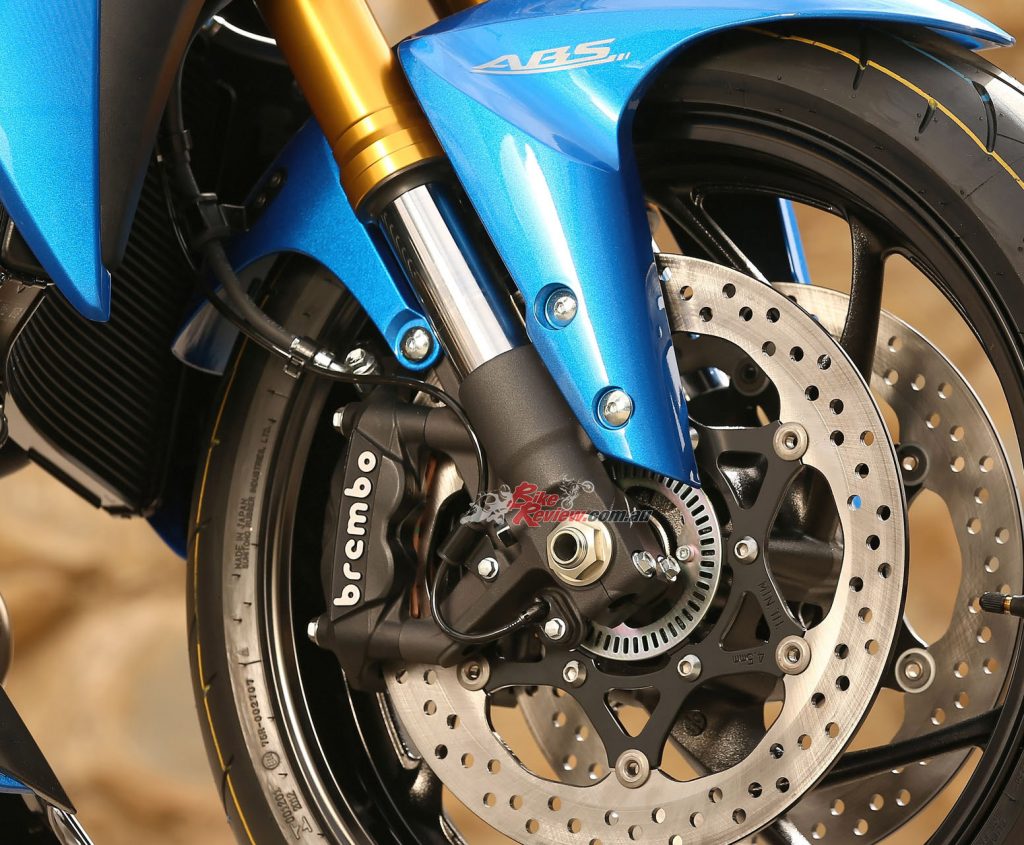
The sharp, futurist body lines travel all the way down to the mud guard. subtle touches like this really give the bike an aggressive look.
STYLING
A wild, bold and aggressive look was the brief for designer Shinji Tamura – with the look of a crouching beast, not a Transformer or Manga styling… With a target rider above the age of 40, a touch of class and style also had to go into the design process. The headlight, a multi-reflector type with 60/55w bulb, has two LED lights positioned under it to give a ‘fang’ effect, while the rear end has an LED taillight with a double lens to add some style and class, according to Tamura-San.
The belly-pan is designed to have sharp lines and surfaces that connect dynamically to the tail section when viewed from the side, while the radiator shrouds are designed to emphasize a more dynamic and fierce side to the bike – as well as actually doing their job of directing airflow for cooling and rider comfort. Smart use of black plastics and painted surfaces gives the tail unit a very sharp and clean look and the short tail section gives a streetfighter touch to the bike. The stubby muffler adds to the aggressive look to the rear of the bike, as do the sportsbike style seats. Pillion comfort was not a priority as the target rider is a weekend quick blaster who rarely does long trips or takes pillions…
ACCESSORIES
The GSX-S1000 is built to be customised and Suzuki have recognised this by releasing a range of accessories for owners to personalise their new bike. We won’t get the Yoshimura muffler here in Australia, due to ADRs, however the rest of the accessories will be available through your local Suzuki dealer. Visit suzukimotorcycles.com.au for more info.

Suzuki sat back and watched as all the big manufacturers released their nakedbikes, the wait paid off as they came up with something spectacular to look at and amazing to ride.
CONCEPT
Suzuki has arrived late to the nakedbike sports class, however, they sure have done their research and that shows in the product they have delivered. The GSX-S is aimed at the experienced rider who has previously owned sportsbikes, who rides mainly on weekends for a quick fun spin up the mountain and does not want a full-blown sportsbike anymore. Key factors were that the bike had to be lightweight, nimble handling, agile, have strong acceleration and be good quality and stylish. Top speed and outright power were not concerns. The bike had to have an exciting exhaust and intake sound, sportsbike brakes, be fun to look at and admire in the garage, have strong top-end and traction control and ABS. Importantly, Suzuki wanted ‘No Gimmicks’ on the bike, as they said, they are targeting experienced riders who know their stuff…
2015 Suzuki GSX-S1000 ABS Specifications
Price New 2015: $15,290
Used Price 2025: $7,500 – $11,000
Average KM travelled: 12,000 – 40,000
Claimed Power: 107kW[146hp]@10,000rpm
Claimed Torque: 106Nm[80ft-lbsft-lbs]@9500rpm
Wet Weight: 209kg
Fuel Capacity: 17L
Engine: Liquid-cooled, four-stroke, forward-inclined parallel four-cylinder, four-valve per cylinder, DOHC, 73.4 x 59mm bore x stroke, 999cc, 12.1:1 compression, FEM pistons, 43mm throttle-bodies, 10-hole long-nose fuel injectors, water-cooled oil-cooler, SCEM plated cylinders, SET exhaust system
GEARBOX: Constant mesh, six-speed CLUTCH: Back-torque limiter wet multi-plate
Chassis: FEM designed alloy frame, alloy braced swingarm
Rake: 25º Trail: 100mm
Suspension: 43mm KYB fully adjustable telescopic forks, 120mm travel, KYB rear shock, link type single shock, rebound and preload adjustment, N/A travel. Brakes: Bosch ABS system, Brembo radial-mount 32mm four-piston calipers, 310mm semi-floating stainless steel rotors, 220mm rear rotor with Nissin caliper, Nissin conventional master-cylinder. Wheels & tyres: Cast alloy six-spoke 17in, Dunlop D214 120/70-17in (f), 190/50-17(r)
Dimensions:
Seat height: 815mm
Overall height: 1080mm
Overall length: 2115mm
Width: 795mm
Wheelbase: 1460mm
Instruments & Electronics: Multi-function LCD display, Ride Modes, ABS
2015 Suzuki GSX-S1000 Gallery
Ratings | Throwback Thursday: The Suzuki GSX-S1000 Turns 10!

















